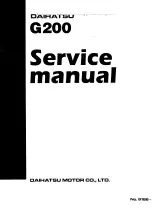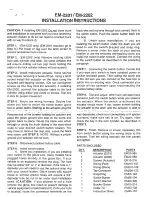
WWW.MANUALS.WS
WWW.MANUALS.WS
173
2-door models
4-door models
Keep your tire pressures at the proper
level.
The recommended cold tire pressures,
tire size and the vehicle capacity weight
are also given in Part 8. They are also on
the tire pressure label shown.
You should check the tire pressures every
two weeks, or at least once a month. And
do not forget the spare!
Incorrect tire pressure can reduce tire
life and make your vehicle less safe to
drive.
Low tire pressure results in excessive
wear, poor handling, reduced fuel econo-
my, and the possibility of blowouts from
overheated tires. Also, low tire pressure
can cause poor sealing of the tread bead.
If the tire pressure is excessively low,
there is the possibility of wheel deforma-
tion and/or tire separation.
High tire pressure produces a harsh ride,
handling problems, excessive wear at the
center of the tire tread, and a greater pos-
sibility of tire damage from road hazards.
If a tire frequently needs refilling, have it
checked by your Toyota dealer.
The following instructions for check-
ing tire pressure should be observed:
The pressure should be checked
only when the tires are cold. If your
vehicle has been parked for at least 3
hours and has not been driven for
more than 1.5 km or 1 mile since, you
will get an accurate cold tire pressure
reading.
Always use a tire pressure gauge.
The appearance of a tire can be mis-
leading. Besides, tire pressure that
are even just a few pounds off can de-
grade handling and ride.
Take special care when adding air
to the compact spare tire. The
smaller tire size can gain pressure
very quickly. Add compressed air in
small quantities and check the pres-
sure often until it reaches the specified
pressure.
Do not bleed or reduce tire pres-
sure after driving. It is normal for the
tire pressure to be higher after driving.
Never exceed the vehicle capacity
weight. The passenger and luggage
weight should be located so that the
vehicle is balanced.
Checking tire pressure
















































